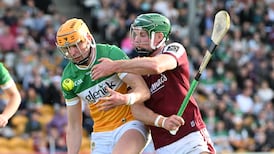GAELIC GAMES:TELEVISION AUDIENCE figures released by RTÉ show Gaelic games accounted for three of the four most-watched sports broadcasts of 2010. All told, there are four GAA fixtures, four rugby internationals and two soccer internationals in the top 10.
Last September’s All-Ireland hurling final between Tipperary and Kilkenny attracted 979,000 viewers and was watched by more people than any other RTÉ programme apart from The Late Late Toy Show in December.
Number two in the sports list was the All-Ireland football final (770,000) between Cork and Down, a slightly unusual pecking order in that, according to RTÉ, football finals would draw bigger audiences seven years out of 10.
Third is the World Cup final (762,000), between Spain and the Netherlands in July, and one place behind, the Cork-Dublin All-Ireland semi-final in August (629,000).
“These are very good numbers for us and clearly show the importance of sport to the viewing public,” was the reaction of Ryle Nugent, RTÉ group head of sport. “Two of the top 10 sports programmes are also in the overall top 10 broadcasts and the World Cup final in July is just outside at number 11.”
Given the World Cup final was also being screened on BBC and UTV and the rugby internationals on BBC, RTÉ’s figures held up in the face of that competition (unofficial estimates put the ratios between RTÉ and other channels showing the same events as varying between 5:1 and 10:1).
“From our perspective it was very heartening that the national games were so well received,” says Nugent, “and that in respect of other sports, 60 per cent of the top 10, we had significant competition in our marketplace from the best funded and most technologically advanced sports broadcasters in Europe, if not in the world.
“So, credit goes to the editorial and production teams for making programmes the Irish public wants to watch and in 60 per cent of cases had significant competitive choice.”
Commenting on the strong showing of the hurling final, Nugent said the historical nature of the match had drawn in audience interest from beyond the dedicated sports viewer.
“When a significant event comes along and everybody’s talking about it then people tune in to watch it. The hurling final is a perfect example of that. Kilkenny’s five-in-a-row is what it was about. It went beyond being a sports story and became a national event, and although All-Ireland finals are always there or thereabouts, that’s why the hurling final attracted even more interest than usual.”
The figures also demonstrate the growing popularity of rugby, which in 2003 – the year before Ireland won its first Triple Crown of the professional era – could only manage one broadcast in the top 10 (the Grand Slam decider against England came fifth in the list with 504,000).
In 2010, Ireland’s Six Nations matches against France, England and Scotland, as well as the November international against New Zealand, were in at numbers four, five, six and 10 respectively.
“Since the structure of the professional game emerged in the Magners League, the Heineken Cup, the Six Nations and the World Cup that means that rugby isn’t just present for five weeks of the year,” Nugent said. “Rugby is the sport that’s developed its structures to the greatest extent over the past 10 or 15 years and the audience has followed.”
Although soccer’s representation by only two matches is low, the nature of last year distorted the picture a bit.
There were no qualification-defining internationals in the spring, as it was a World Cup year, and the current qualification group is short of box-office appeal. A year previously the World Cup qualifiers against Italy and France were among the most watched sports events of 2009.
THE third national GAA programme and memorabilia collectors’ fair takes place today at the Cardinal Ó Fiaich Library and Archive in Armagh (10.30am). There is no charge for entry.
















